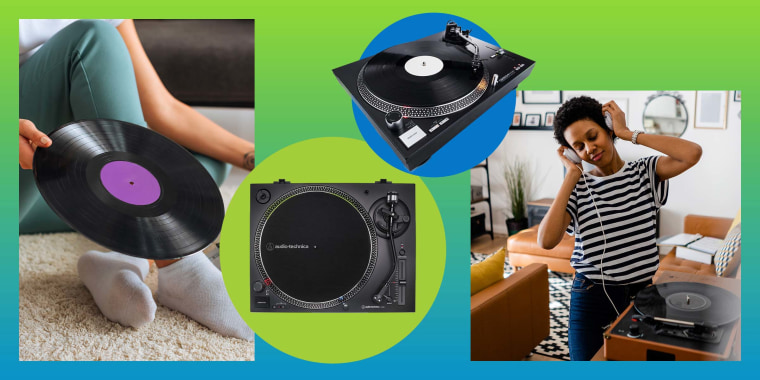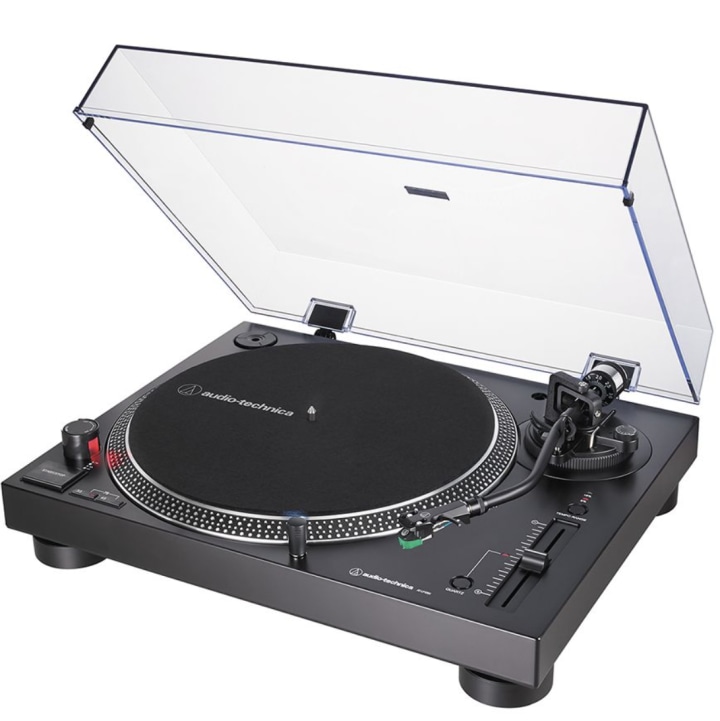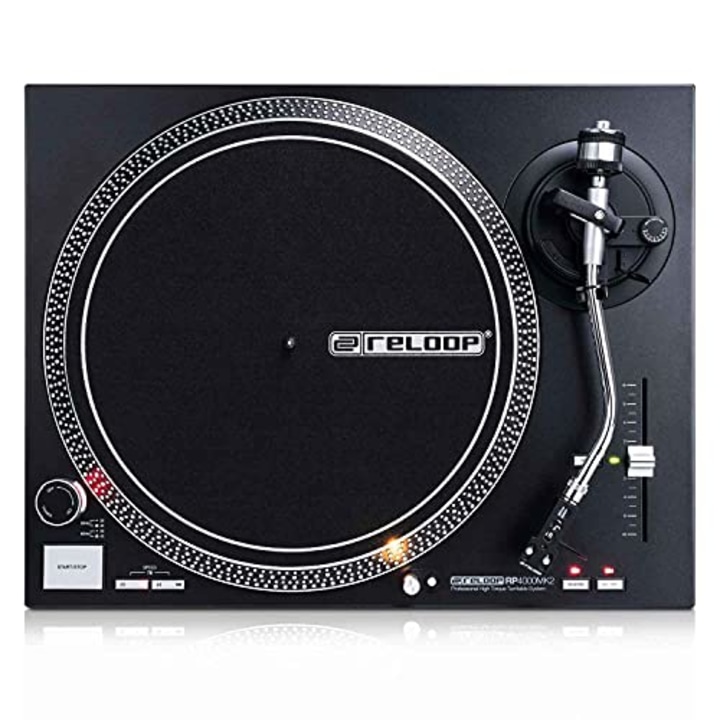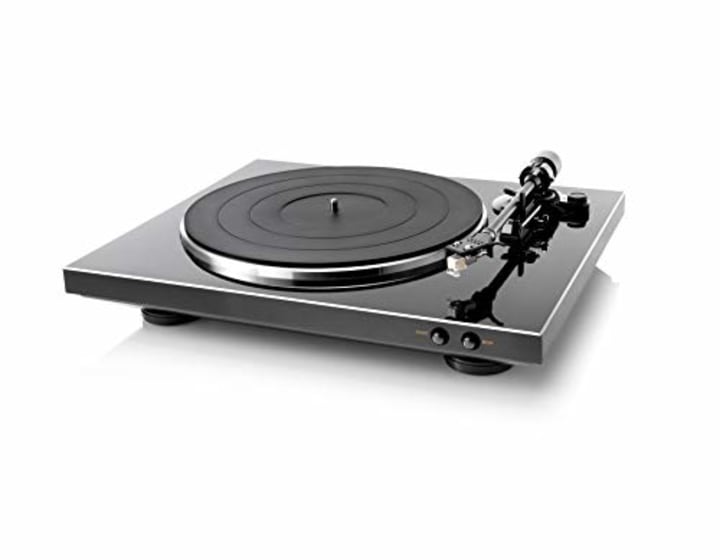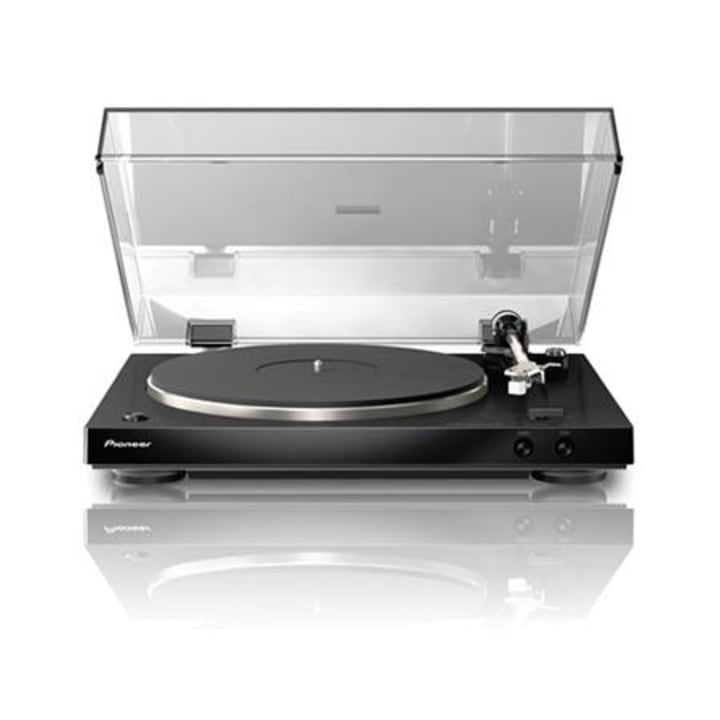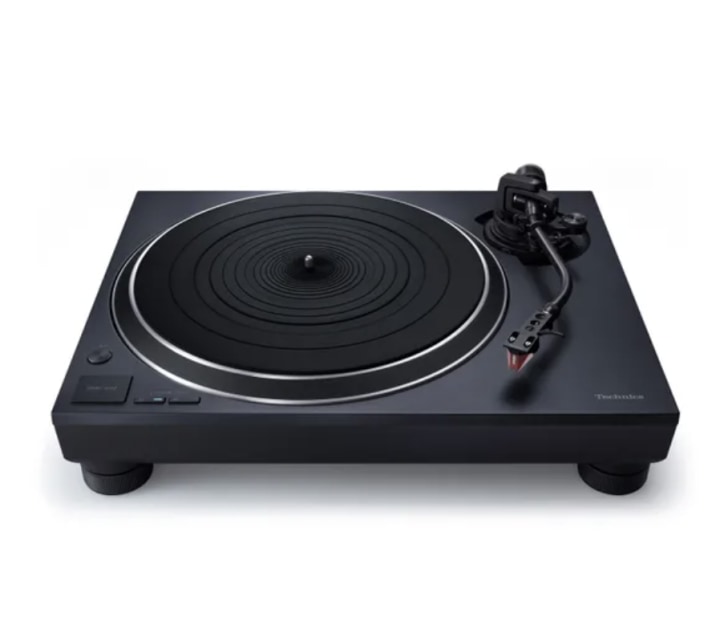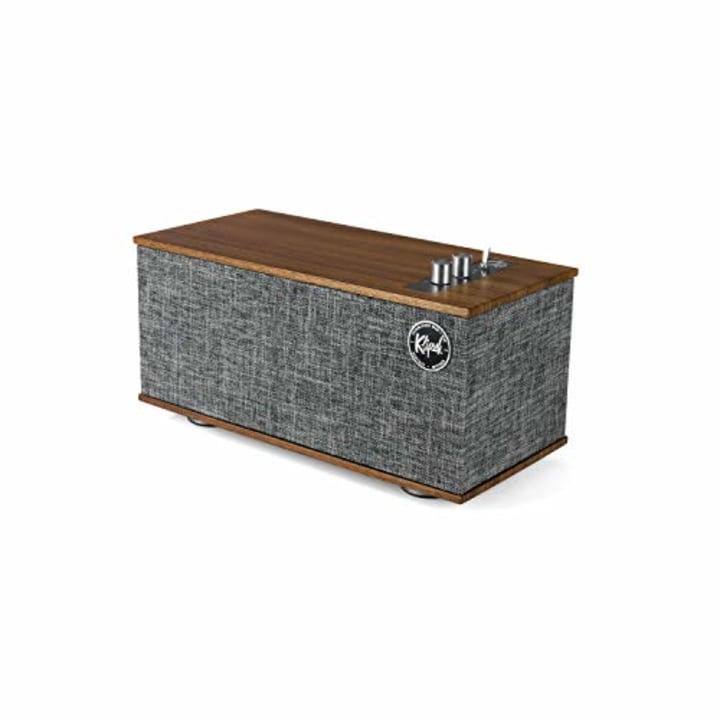What’s old is new again, particularly when it comes to music. In 2020, vinyl record sales surpassed CD sales for the first time since the 1980s, totaling $232 million of revenue in the U.S. — and 62 percent of all physical music revenue — according to data from the Recording Industry Association of America. And while shoppers from older generations are most likely to pay for music on vinyl, more than a quarter of millennials and Gen Zers (28 percent and 26 percent, respectively) said they’d spend the money in a 2019 YouGov survey. Listeners are newly discovering older artists, too: In a recent survey from Dolby, almost half of respondents (and nearly 70 percent of Gen Zers) said they'd recently started listening to a song first released over a decade ago.
SKIP AHEAD The best turntables
If you’re new to vinyl records, you may have no idea where to look or what to look for when it comes to buying a turntable (or record player, but we’ll get to that distinction later). The music player can be quite complex, and words like “preamp,” “tonearm” and “rumble rating” might be unfamiliar. Turns out the experts say you don’t have to be an expert to get the most from your turntable: We spoke to turntable repair specialists and record store owners about the inner workings of turntables and what you need to know before buying one, as well as rounding up some of their favorite models.
What is a turntable?
Though many people use the terms “turntable” and “record player” interchangeably, the two aren’t the same. A turntable is actually part of a record player: It houses the platter that holds (and spins) your record while it plays. Unlike a record player, though, a turntable does not come with a built-in preamp, amplifier or speaker — all of these come together in a record player to simplify the experience. While a record player is an all-in-one listening device, a turntable requires additional equipment before it can be used and is preferred by those who want to pick out all of their equipment, experts told us.
Before making an informed purchase of a record player or turntable, it helps to understand its main parts. To help us drill into that, we spoke to Thomas Rasmussen, the owner of Rasmussen Turntable Repair. Rasmussen’s worked with more than 250 turntable models — here’s his guidance around the most important components of a turntable and what they do.
- The platter is the “rotational part” of the turntable where the record sits.
- The center of the turntable, over which the record sits, is the spindle.
- The tonearm reads the record while it plays in order to play music.
- At the end of the tonearm is the cartridge, which uses a stylus (sometimes called a needle) to play music. “Magnets pick up the signal from the needle going between the grooves as your stylus goes up and down,” Rasmussen explained. This signal gets sent down the tonearm wires to an electronic board where your preamp and receiver amplify it.
- A preamp, or preamplifier, amplifies the signal from the turntable — a weak signal on its own — and feeds it into an amplifier or receiver. Some turntables come with built-in preamps and others require a separate purchase.
- An amplifier further amplifies the audio signal from a record player so that it can be played over speakers.
- A receiver is similar to an amplifier, but often includes a built-in radio component, a tuner and other functions depending on the model. Some receivers, like the Sony STRDH190, come with built-in preamps.
How to shop for a turntable: What to consider
Once you can tell your platters from your preamps, you need to start thinking about what type of turntable will work for you, often a construct of your experiences and budget. We broke down some of the most important features and specs experts told us to look for while shopping for a new turntable.
Operation type: Automatic, semi-automatic and manual
Turntables either operate as automatic, semi-automatic or manual systems. Though many turntable enthusiasts prefer manual tonearms — which forces (or allows) them to carefully place the needle onto the spinning record themselves — the choice is largely one of style. An automatic one won’t diminish the sound quality, said Rick Wojcik, co-founder of Dusty Groove record store in Chicago. Rasmussen agreed, adding that a fully automatic model is a good option for beginners. “There’s less risk in scratching your records and, upon the end of the record, it’s not sitting there if you forget about it going over and over,” he said.
Semi-automatic turntables are similar to automatic ones — they will automatically stop running at the end of a record, according to Rasmussen. “If it’s someone who’s not always the most attentive, their turntable isn’t going to keep running and keep digging a groove at the end of the record,” he said. However, semi-automatic turntables won’t lower the tonearm — this needs to be done manually.
A manual turntable is “more of a hands-on experience,” but because of that, you “need to be more attentive,” Rasmussen said. A manual player won’t automatically turn on or shut off, either, and the tonearm needs to be placed by hand.
Wow and flutter
A turntable’s wow and flutter refers to a machine’s ability to filter out distortions and play music at a consistent speed. In other words, it measures a machine’s sound quality and performance. Many things can impact a machine’s wow and flutter, including the motor type, the age of the machine, its quartz lock, the weight of the machine and the design of the chassis (or base).
“Your turntable turns at a constant speed — you have your voltage from your outlet and that goes through your turntable, [but] it’s not always consistent,” Rasmussen explained. “A good way to put this visually: If you have a light on in a room and you plug a vacuum in, you see the fluctuation of power to the light,” he said. A similar thing can happen with a turntable: If something else gets plugged into the same circuit and it demands more power, the turntable will start to skip or slow down.
Belt drive versus direct drive
The difference between a belt drive turntable and a direct drive turntable lies in what’s powering the platter. A belt drive turntable uses a belt to spin the platter, which can lead to more noise from the motor, Rasmussen said. “With belt drive, you also have [more] wow and flutter,” he added. This type of motor is going to be more likely to show [voltage changes], since it tends to have a lighter platter. However, according to Wojcik, belt drive turntables have less distortion, since the motor is not directly attached to the platter.
Direct drive turntables, meanwhile, are powered by magnets, which means there is no physical contact with the platter. The motor in these turntables is right underneath the platter and, according to Rasmussen, “the inertia from the platter keeps it rotating pretty consistently.” Compared to belt drive turntables, direct drive turntables can reach the intended speed much faster, but, as Wojcik mentioned above, the noise from the motor is more likely to get picked up by your machine.
Cartridge quality
According to Rasmussen, the quality of your cartridge will have the biggest effect on the quality of your sound. However, he said that once you’re past the $250 mark, “there’s not much of a difference.” Even if your turntable comes with a cartridge, he recommended investing in a higher quality one to maximize your listening experience and minimize damage to your record grooves.
Tracking force adjustment
Rasmussen said that it’s important to buy a turntable that has a counterweight on the tonearm. With a counterweight, you can adjust the weight of your tonearm to adjust the tracking force, which ensures that the tonearm isn’t too heavy — if it’s too heavy, the tonearm can damage the record grooves, and if it’s too light, you might lose sound quality.
Rumble rating
A turntable’s rumble rating measures “how it takes vibrations,” Rasmussen explained. Ideally, you want a turntable with a higher rumble rating, in the -40 or -50 range at minimum, he said. It seems counterintuitive, but when it comes to rumble rating, numbers that are technically “higher” are actually worse. In other words, a -80 rating is much better than a -20 rating. Turntables with heavier bodies will have higher rumble ratings, since they’re less likely to pick up vibrations from external movement.
The best turntables, according to experts
Both Wojcik and Rasmussen suggested looking for a used turntable if you want to save money or prefer vintage models that may offer superior sound quality — you can find those at your local record store or online at specialized turntable purveyors. However, in case you’re new to the world of vinyl and want to start with something more modern, we’ve rounded up a selection of turntable options, all of which are expert-recommended.
Best entry-level turntable with a direct drive and built-in preamp: Audio Technica
Audio Technica AT-LP120XUSB
According to Rasmussen, this manual model from Audio Technica with a built-in preamp is a great entry-level turntable. “It is user-friendly and modeled after the acclaimed Technics SL-1200 MKII from the 1970s,” he explained.
Rasmussen suggested buying a new cartridge if you do go with this model, since the one that comes with it is lower quality — he likes the Ortofon Red 2M or Blue 2M cartridges.
Best direct drive turntable for advanced listeners: Reloop
Reloop 4000 MK2 Direct Drive DJ Turntable
A similar model to the Audio Technica AT-LP-120XUSB, the Reloop 4000 MK2 is a good option for slightly more advanced turntable users looking for more control over their records. It is a quartz-driven direct drive turntable, which means that it will maintain a stable speed when you play your records and reduce wow and flutter, Rasmussen said.
It does not have a built-in preamp, which means you will need to buy one separately (the experts say which preamp to get is largely a matter of personal preference).
Best automatic belt drive turntable with built-in preamp: Denon
Denon DP-300F
Rasmussen said that this turntable is one of the better modern options, noting that it is a “solid build with easy-to-use functions and a nice appeal.” At 12 pounds, this turntable has a nice weight to it, which he noted helps it prevent vibrations from becoming audible. This Denon model is fully automatic: All you have to do is load your record onto the platter and let the machine do the rest.
Best dual-layered chassis automatic turntable with built-in preamp: Pioneer Electronics
Pioneer Electronics PL-30-K Audiophile Stereo Turntable
This belt drive turntable from Pioneer Electronics has a dual-layered chassis design, which means that the base is thicker to “further increase the damping of vibrations,” according to Rasmussen. It’s also fully automatic, so all you have to do is press a button to listen to your records. Like most of the other models on this list, it comes with a built-in preamp that can be switched on or off.
Best splurge manual turntable with built-in preamp: Technics
Technics SL-1500C Direct Drive Turntable
This is one of the best turntables money can buy, according to Rasmussen: It’s the modern version of the popular SL-1200 MKII model with improvements to things like the motor and plinth (or base). At just over 21 pounds, the quartz-driven machine is one of the heavier models on our list (which is great for its rumble rating), and it’s a direct drive turntable, which means it will “hold the platter at a more consistent speed [and] reduce wow and flutter,” Rasmussen explained.
Best turntable accessories: Cartridges, stereos and more
To help you complete your set-up, we also included some expert-recommended and highly rated accessories for your turntable, including cartridges and stereos (these can make for great gifts for the turntable enthusiast on your list).
Klipsch The One II Phono Wireless Shelf Stereo
Rasmussen recommended this stereo as a great all-in-one system. It includes a built-in preamp to connect directly to your turntable and features Bluetooth technology for when you want to use it with your phone or other devices. The stereo system uses two 2 ¼-inch, full-range drivers and a 4 ½-inch woofer. Put simply, buy this if you grab a turntable that doesn’t come with a built-in preamp and you don’t want to buy a separate amplifier and speakers.
Ortofon 2M Red Moving Magnet Cartridge
Rasmussen said that Ortofon’s 2M Red and 2M Blue cartridges offer “the best bang for your buck.” The 2M Red is the more affordable of the two options and can fit most turntables, according to the brand.
Should you buy an all-in-one record player? Experts say no.
In recent years, many notable companies have started to make beginner-friendly, all-in-one record player systems that eliminate the need to buy various costly accessories. Though these budget-friendly, entry-level record players can be tempting for newbies, experts told us that they’re not worth the money and space you save: Tech reviewers like Gear Patrol have also noted they break often, can ruin your records and lack in sound quality.
“They not only sound terrible, [but] they [also] break down [and] they have a lot of problems with tracking. You’re really not getting the full experience,” Wojcik told us. When Dusty Grooves bought and sold record players and turntables, the store dealt with a disproportionate amount of returns on these types of all-in-one machines, he said. “People would just complain,” he said.
According to Rasmussen, using a low-end, all-in-one record player can also damage your records over time. Many of these record players have tonearms without tracking force adjustment, he explained — if the tracking force is too high, it can dig through the grooves of your records and destroy them.
Not everyone who buys an all-in-one record player has a bad experience — in fact, several Select staffers own them and haven’t had any issues thus far. If you don’t plan on using your record player frequently or don’t mind sacrificing sound quality to save some money, an all-in-one player might just be perfect for you, though we recommend keeping these caveats in mind.
Catch up on Select’s in-depth coverage of personal finance, tech and tools, wellness and more, and follow us on Facebook, Instagram and Twitter to stay up to date.
